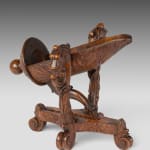Scandinavian Birch Bottle Cradle and Pourer
PROBABLY NORWAY, CIRCA 1800
25 x 33.8 x 25.3 cm
9 ¾ x 13 ¼ x 10 in
9 ¾ x 13 ¼ x 10 in
7068
Further images
-
(View a larger image of thumbnail 1
)

-
(View a larger image of thumbnail 2
)

-
(View a larger image of thumbnail 3
)

-
(View a larger image of thumbnail 4
)

-
(View a larger image of thumbnail 5
)

-
(View a larger image of thumbnail 6
)

-
(View a larger image of thumbnail 7
)

-
(View a larger image of thumbnail 8
)

-
(View a larger image of thumbnail 9
)

-
(View a larger image of thumbnail 10
)

With leaves carved to the underside of the cradle and the base, with a ball handle, supported on two scrolling supports terminating in horse's heads, the cradle adjusted with a...
With leaves carved to the underside of the cradle and the base, with a ball handle, supported on two scrolling supports terminating in horse's heads, the cradle adjusted with a ratchet, on a rectangular base raised on four foliate decorated scroll feet.
Edward H. Pinto illustrates a Georgian cradle wine pourer of similar form and writes 'The true Georgian bottle pourer is formed as a bottle cradle, built up on a ramp, with a hinge or pivot at the top and some form of ratchet, to enable the tilt of the bottle to be adjusted as it empties. Judging by the few survivals, bottle pourers were individually designed and made in small quantities and appear always to have been of superlative quality, intended for the wealthy connoisseur...' (Treen and other Wooden Bygones (Bell & Hyman, London 1969), p. 63 and pl.52).
Butler and Walkling refer to such items as ‘decanting machines’ or ‘bottle tilters’ and discuss later metal examples used mainly in France. They comment ‘French examples tend to be constructed entirely in steel or cast iron and it is doubtful that any date from before the beginning of the 19th century. Portuguese examples are known to exist and it is probably from that part of the world that the idea was first introduced to England. Early English examples are somewhat different and tend to be made of mahogany. At their simplest they comprise a bottle-sized open-topped box with a slot in end to accommodate the neck and an equally simple frame on which the box pivots. In this case no mechanism is involved.' (The Book of Wine Antiques, Antique Collectors’ Club, 1986, p. 250).
Edward H. Pinto illustrates a Georgian cradle wine pourer of similar form and writes 'The true Georgian bottle pourer is formed as a bottle cradle, built up on a ramp, with a hinge or pivot at the top and some form of ratchet, to enable the tilt of the bottle to be adjusted as it empties. Judging by the few survivals, bottle pourers were individually designed and made in small quantities and appear always to have been of superlative quality, intended for the wealthy connoisseur...' (Treen and other Wooden Bygones (Bell & Hyman, London 1969), p. 63 and pl.52).
Butler and Walkling refer to such items as ‘decanting machines’ or ‘bottle tilters’ and discuss later metal examples used mainly in France. They comment ‘French examples tend to be constructed entirely in steel or cast iron and it is doubtful that any date from before the beginning of the 19th century. Portuguese examples are known to exist and it is probably from that part of the world that the idea was first introduced to England. Early English examples are somewhat different and tend to be made of mahogany. At their simplest they comprise a bottle-sized open-topped box with a slot in end to accommodate the neck and an equally simple frame on which the box pivots. In this case no mechanism is involved.' (The Book of Wine Antiques, Antique Collectors’ Club, 1986, p. 250).










